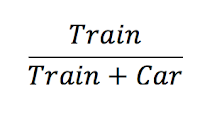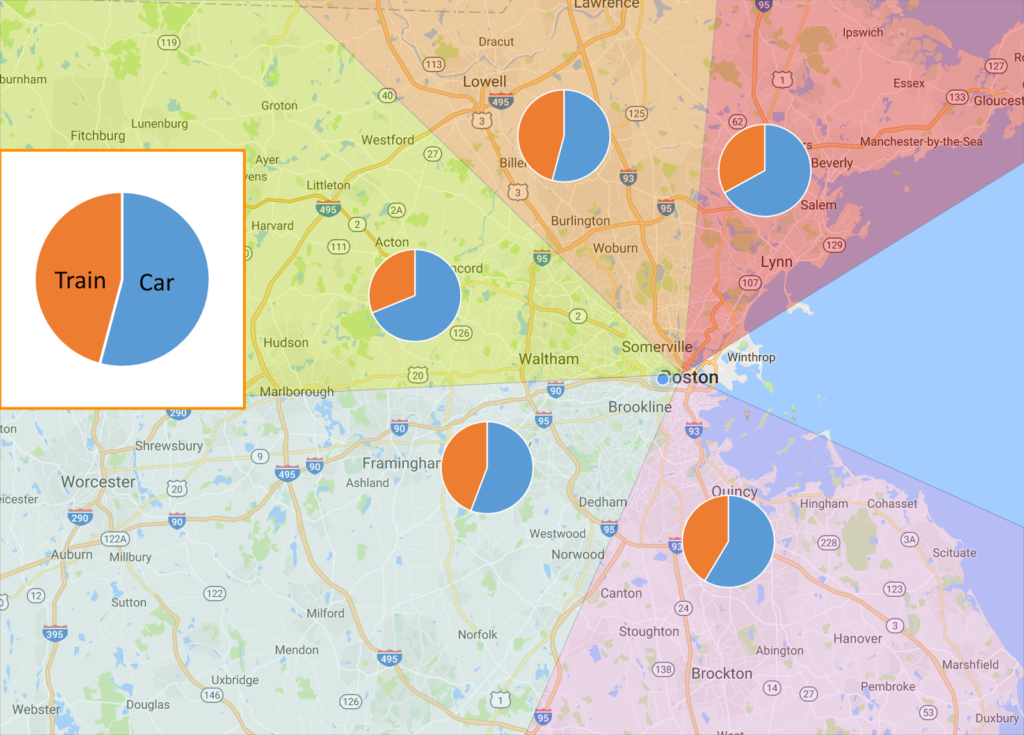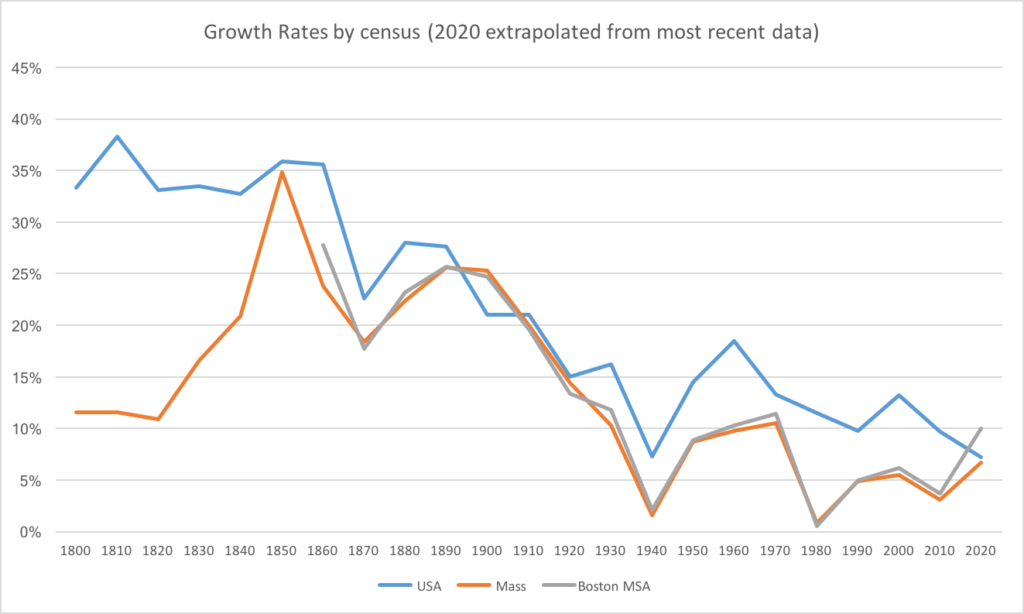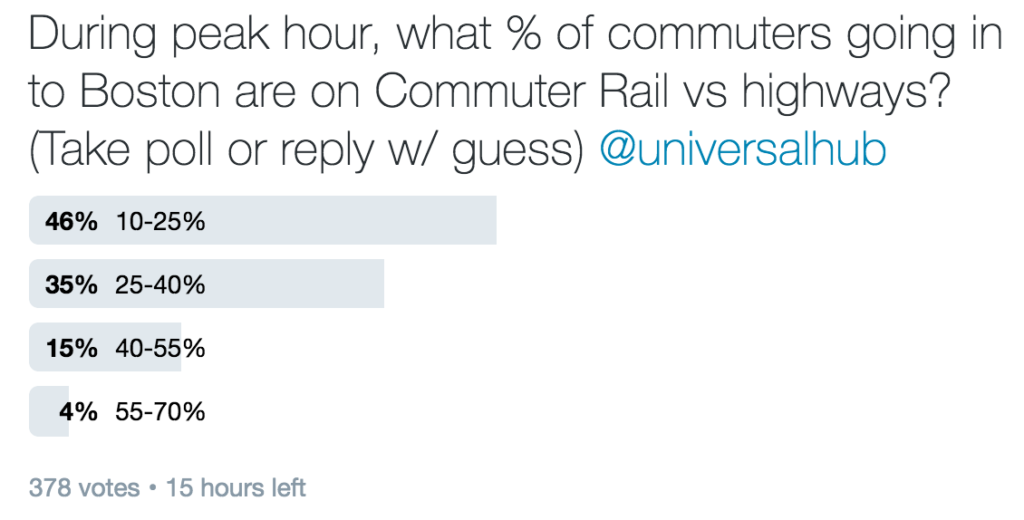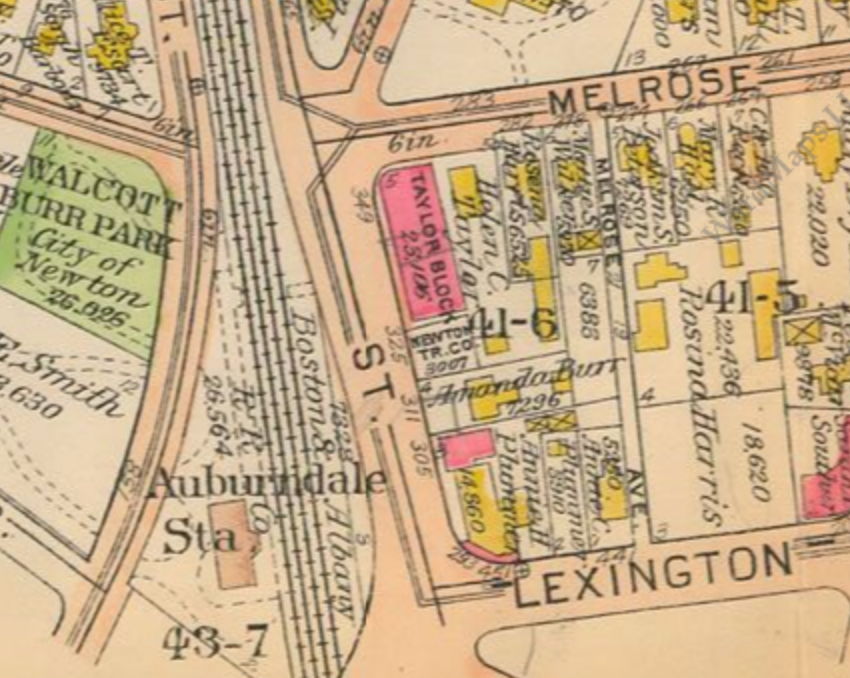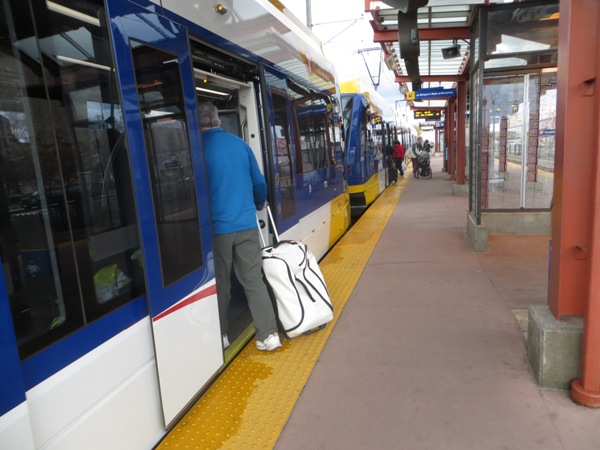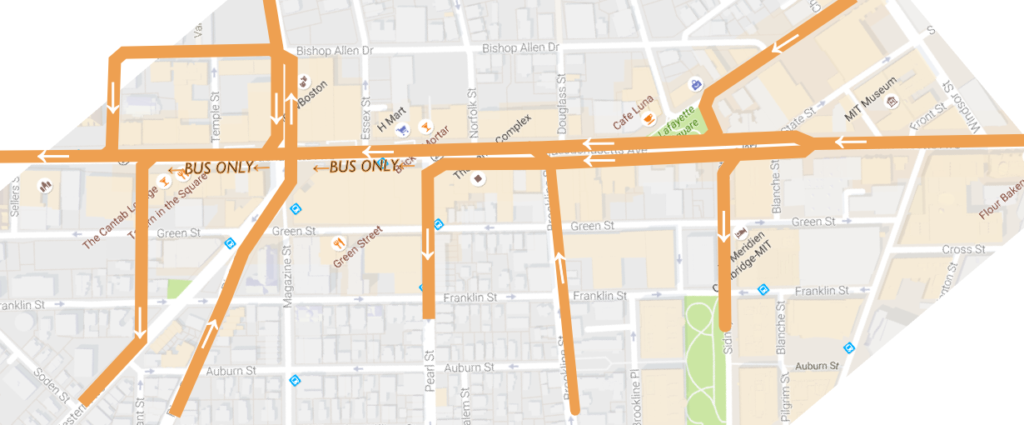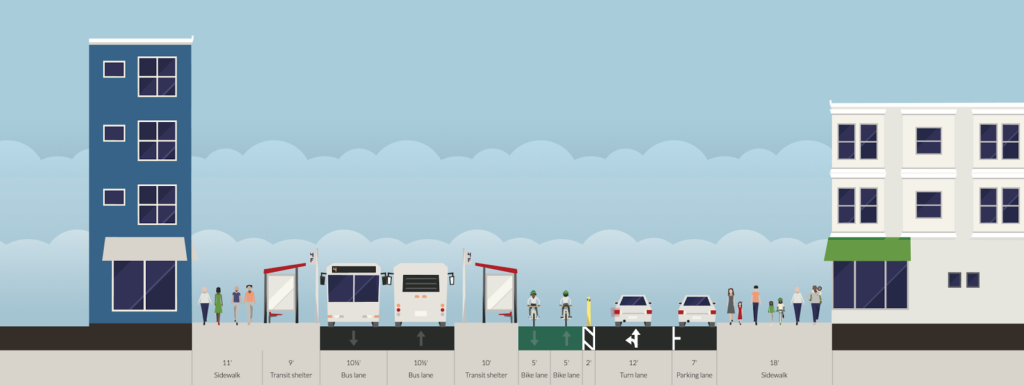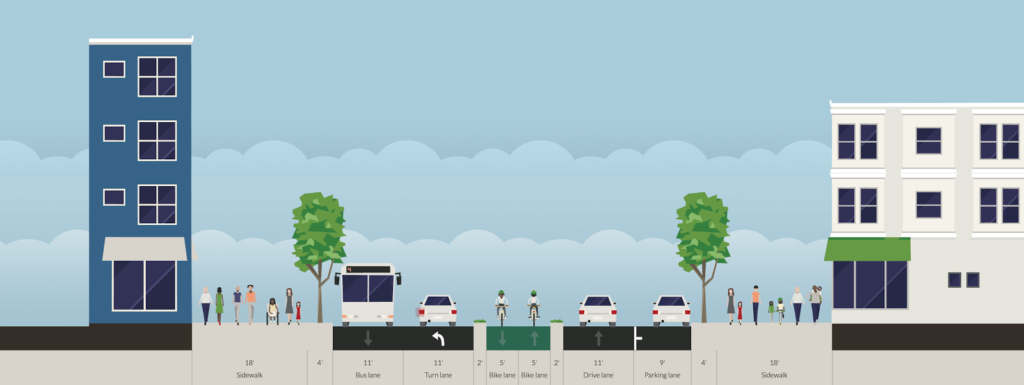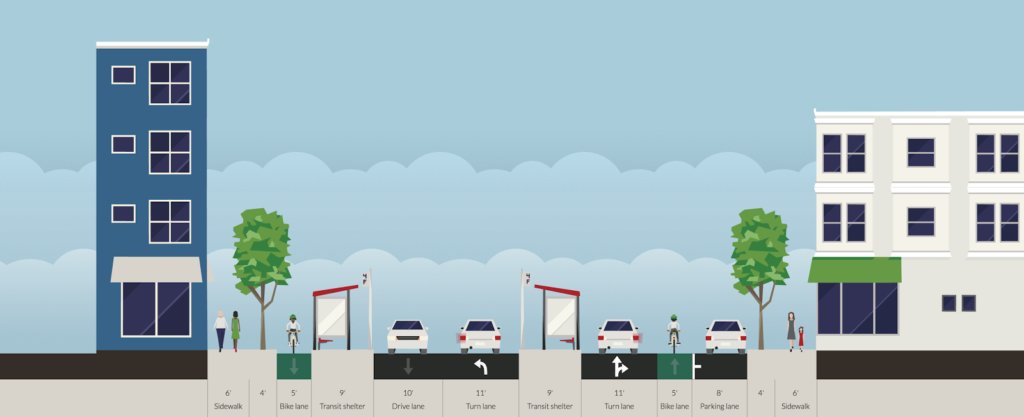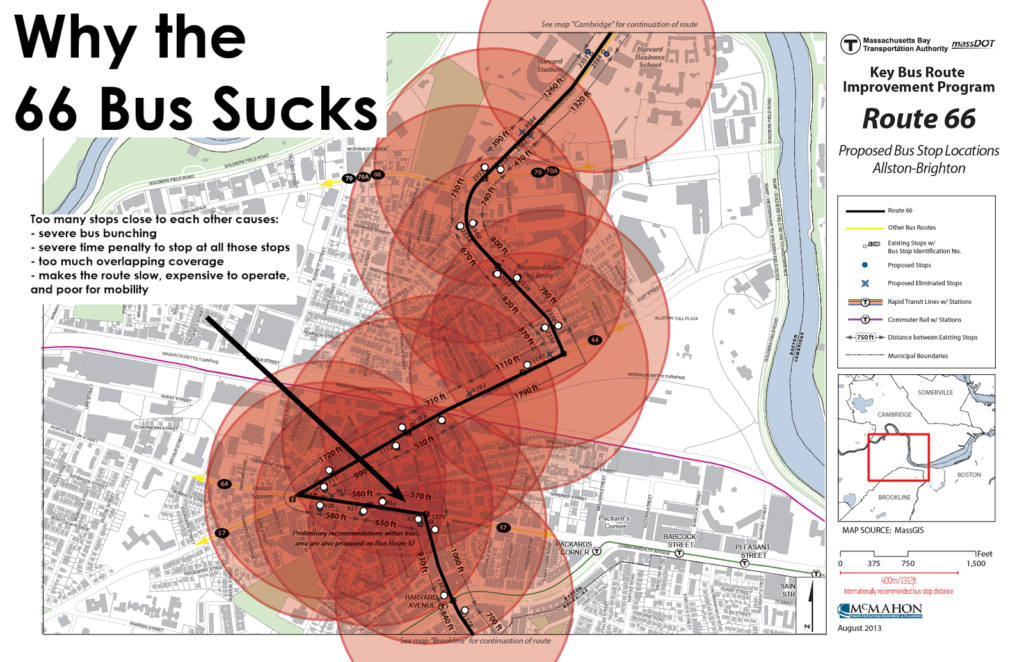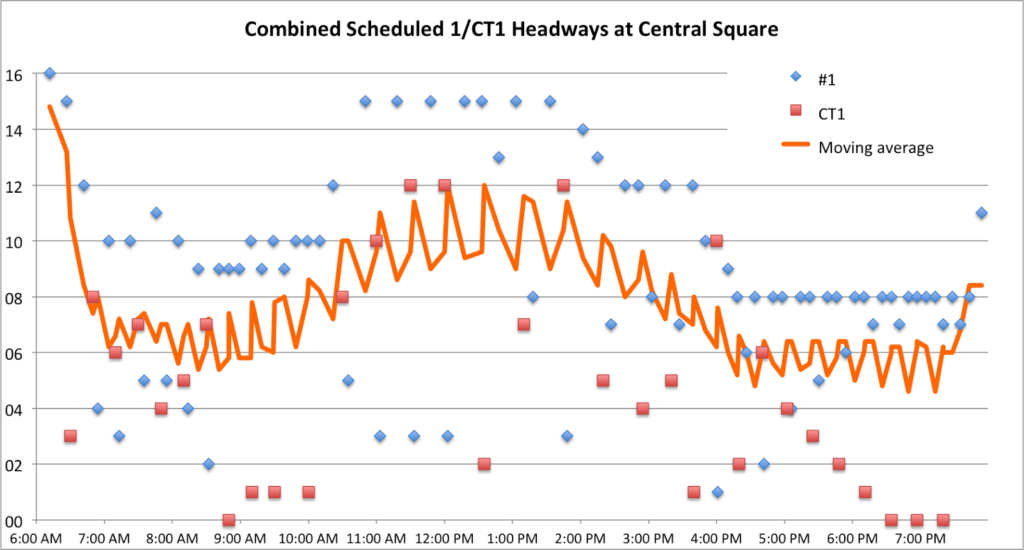Of all the peculiarities in the MBTA’s Commuter Rail operation, one of the most apparent is the Providence Line. Where else can you find a modern, high-speed, electrified railroad with diesel-powered trains operating underneath the wire? Basically nowhere. Yet the MBTA incongruously runs diesels on the line, and not only that, it doesn’t spec its equipment for more than 80 mph, so the trains run at half of the top speed. The Providence Line is the system’s busiest, with upwards of 1000 passengers boarding daily at each station, but most board via the trains’ steps, lengthening dwell times considerably. It’s a 21st century railroad, but the MBTA runs it like the 19th. This provides far worse service than it should and costs the T—and the taxpayer—a lot of money while providing far less public benefit, in terms of regional connectivity and short travel times, as it could. Electrification would also allow for much more efficient utilization of equipment: with the same number of crews and cars on the line today, it would allow twice as many trains at rush hour.
Electrifying the Providence Line for the MBTA would not be trivial, but the costs would be relatively low given the existing infrastructure, and it provide benefits not just for Providence Line riders but for Amtrak riders and nearby residents. It would allow the diesel equipment on the Providence Line to move to other parts of the system, replacing the oldest equipment elsewhere. It would also be the first step towards building Regional Rail: a rail system which not only takes workers downtown at rush hour, but also provides mobility across the region. And where better to start than between the capital cities of Massachusetts and Rhode Island?
This post will address several of the benefits of upgrading the Providence Line to accommodate fast, electric rolling stock, and how they will allow the MBTA and RIDOT (which subsidizes the portion of the line serving Rhode Island) to increase service, decrease operating costs, and provide a better, more competitive product on the rails. With the MBTA’s fleet aging, it’s high time to examine the future needs of the network, and to begin the move to electric operation and a Regional Rail system.
Electric trains are cheaper to buy
The MBTA’s most recent locomotive procurement had a unit cost of $6 million. The unit cost for the M8s delivered to MetroNorth has been in the range of $2.25 to $2.5 million, about the same as an MBTA Rotem bilevel coach. While the bilevel coaches do have more capacity than the single-level cars, a locomotive and six bilevels has the same capacity and costs the same amount as a train of eight EMUs. (Bilevel EMUs are also an option, although Northeast Corridor-spec’ed bilevel equipment does not yet exist, New Jersey may order some soon. If so, costs may not be appreciably be higher. Single level equipment with a proven track record could be bought off the shelf.)
Edit Dec 2018: The FRA has finally updated rules which would allow the T to buy European-spec equipment, like Stadler FLIRTs, which are significantly lighter than an M8 and have better acceleration. Here’s a video of a FLIRT accelerating to 100 mph in 72 seconds.
An electric locomotive pulling bilevel coaches would not have the acceleration benefits afforded by EMUs, but it would still be faster, and the cost of an electric locomotive is about the same as a diesel. Both electric locomotives and EMUs have a proven track record, running daily around the world, including on much of the Northeast Corridor.
In the relatively near-term, the T needs to buy new rolling stock. The T’s entire single-level fleet dates to before 1990; 55 of the cars were built in the ’70s; once the Red Line cars are replaced, they will be the oldest in the system (except, of course, the Mattapan Line). About half of the T’s locomotives date to the same time period, with 20 of them dating to 1973. It is no wonder that the agency is constantly short on both cars and motive power.
The T has had little luck buying new diesel equipment: the 40 new locomotives in the fleet are back and forth to the shops on warranty repair, and coaches aren’t much better: the Rotem bilevel cars are plagued with problems. So instead of doubling down on diesels that don’t work, the T could buy something that does: electric power. Replacing the Providence Line would free up a dozen-or-so train sets, which could be spread across the rest of the system to replace aging diesel equipment there. Thus, the up-front marginal cost of buying new trains would be effectively zero: the T needs to buy new Commuter Rail equipment anyway.
Electric trains are more reliable
Buying electric trains means buying a superior product. While they aren’t perfect, electrics have a much better track record of not breaking down. There’s no perfect metric for this, as I’ve mentioned before, since it is based on agency policy, but the numbers are so staggering they’re almost hard to believe. The T itself reports that its trains break down approximately every 6,000 miles. Meanwhile, the mostly-electrified Long Island and Metro-North railroads see approximately 200,000 miles between major mechanical failures. (A completely different calculation from Chicago shows similar results: the T is way below its peers.) A more apples-to-apples comparison can be made between different equipment types on the LIRR, where the new electric power breaks down ten times less frequently than diesels. While I’d take some of these numbers with a grain of salt, it’s clear that electric-powered railroads are more reliable than diesels.
Another of the costs of running Commuter Rail trains is fueling. Not only does it require staff and fuel, but the trains have to be moved to a fueling location in the middle of the day, which requires additional personnel and operating time and cost. Electric trains carry no fuel, and don’t have to make frequent trips to a fueling facility. They also don’t have to be plugged in or idled at the end of the day: the power to keep them on and get them started is always flowing above the track.
Electric trains are cheaper to run
In addition to the cost of electricity being less volatile than diesel, electric trains are simply cheaper to operate. This is somewhat less the case in the US, where every multiple unit is treated like a locomotive and subject to more stringent maintenance, but the costs are comparable, if not lower. This is especially the case for shorter train sets; if some trains on the Providence and Stoughton Lines used fewer cars, the costs would be significantly less. A locomotive-hauled train uses basically the same amount of power whether it’s pulling four cars or ten. A set of EMUs could easily be broken in half for midday service, reducing operating costs. A study of electrification in Ontario shows annual operation and maintenance savings of 25% (the full study, here, is worth a read). And this assumes low diesel prices. If the cost of oil spikes, electrics pay further dividends.
Electric trains and level-boarding platforms mean faster trips
The fastest trip time for MBTA equipment between Providence and Boston is currently 1:00 (for a 5:30 a.m. outbound trip) with some trips taking as long as 1:14. Amtrak’s Acela Regional trains make the trip in 38 minutes (the Acela Express trains make it in 33). Each stop adds about one minute and 45 seconds to the trip, so additional stops at Sharon, Mansfield and the Attleboros would add 7 minutes, for a total of approximately 45 minutes, end-to-end (Alon levy calculates similar numbers). A commuter from Providence would save half an hour every day; from closer-in stations, round trips would be 20 to 25 minutes faster.
High level platforms are just as important (see this post from California for a very similar issue). Today, Commuter Rail trains will spend two or three minutes of time stopped at major stations while hundreds of people climb the steep, narrow steps onto the cars. High level platforms—like those at Route 128, Ruggles, Back Bay and South Station—allow much faster boarding, increasing the average speed and decreasing the amount of crew time necessary to operate a train. They should be added to all stations, but the busy Providence Line stations are a good place to start.
Faster schedules mean more trains
The total amount of rolling stock required for a railroad is based on the peak requirement for rush hour. Currently, most equipment on the Providence Line runs one rush hour trip in the morning, and one rush hour trip in the evening, with some service midday. For some larger train sets, however, these are the only two trips which are run during the day: a large capital expenditure which is only used 10 hours per week. The first train leaving Providence 5:00 a.m. can make it back to Providence in order to run a second trip that gets to Boston around 9:00 (likewise, a 4:00 p.m. departure can be back to South Station by 6:30, after the tail end of the peak of rush hour) but everything else can only run once inbound in the morning and once outbound in the evening. This approximately 2:40 time (based on stopping patterns and layover) is called the “cycle time” of the line, and the amount of equipment needed to run service is based on this.
Now, imagine that you drop that 2:40 cycle time to 2:00 (45 minutes of running time and 15 minutes to turn at each terminal). That 5:00 a.m. train can run a second trip in to Boston at 7:00. (and maybe even a third at 9:00!). This is much more efficient: each train set can provide twice as much service.
To run service every 30 minutes, you only need four trains. Or, with the eight trains currently needed to run rush hour service from Providence, you could run trains twice as often: every 15 minutes. So instead of the current eight departures from Providence (and one short-turn from Attleboro) between 5:00 and 9:00 a.m.—with as much as 50 minutes between trains—you could instead have 16 departures from Providence: one every 15 minutes. This gives you double the capacity (and if trains are 15 minutes faster than today, you may well need it) and walk up service between the two largest cities in the region.
Off-peak, instead of running a train every one to two hours (or longer: there are service gaps of 2:20 in the current schedule), you could have a train every 30 minutes, again, with the same number of trains. (For the Stoughton branch, a short train could shuttle back and forth between Canton Junction and Stoughton during off-peak hours, meeting the mainline trains at Canton.) This is the promise of Regional Rail: fast, frequent, predictable and reliable trains throughout the day. Electrification and high level platforms would allow the T to operate this level of service with no more operating cost than today.
What’s more, much-improved weekend service on the line would also be possible. Today, there are trains only every two or three hours, and on Sundays, basically no service before noon. (This dates back to the days when the New Haven Railroad operated the service and didn’t provide service before noon, ostensibly because the parochial New Haven thought its customers should be in church, not riding the trains.) Hourly weekend service would be possible with just two train sets.
To visualize this, we can use what’s called a “string diagram” of the current MBTA and Amtrak service during the evening rush hour. The morning rush hour is less complex as there are fewer Amtrak trains in the mix since, except for one overnight train, the first Amtrak arrival from New York doesn’t arrive until close to 9 a.m. Each line shows a train running along the line; steeper lines show slower service. Purple lines show Commuter Rail trains, Light blue lines Amtrak regional service, and dark blue lines Acela Express service.
And here’s the same diagram, but showing every-15-minute EMU Commuter Rail service:
Electric Commuter Rail improves Amtrak service
- Upgrade the electrical systems to allow more power to be distributed across the line. Luckily, someone had their head screwed on straight when it was built and it was designed to have additional power dropped in to place. The T could negotiate with Amtrak to use its $20 million annual “blood money” for this.
- Extend power over any unpowered tracks on the NEC and on the Stoughton branch. This amounts to only a few miles and Stoughton is short enough that it shouldn’t need significant distribution infrastructure. Wires are cheap. Substations, which wouldn’t be necessary, cost.
- Build high-level platforms at Hyde Park, Sharon, Mansfield, Attleboro and South Attleboro stations. This will allow the purchase of rail cars without any “traps” or steps, and will allow much faster boarding and alighting via all doors on a train. It would also make these stations—each of which serves more than 1000 commuters per day—fully ADA compliant.
- Requisition and procure approximately 120 EMU rail cars for operation on the Providence and Stoughton lines, in four-car train sets (or perhaps pairs to allow two-car trains south of Providence and at off-peak times). Peak service from Providence and Stoughton to Boston would require 11 train sets (88 cars), Rhode Island two four-car trains (8 cars), with the required number of spares. The Federal Railroad Administration may allow lighter, faster European-style EMUs to operate on lines like this (update, it has, see above), which would further reduce the cost.
- Build a light-maintenance facility at or near the Pawtucket layover facility, the former Attleboro layover or perhaps in Readville. If built in Rhode Island, the Ocean State could foot these costs in return for maintenance jobs in state. Light maintenance could be conducted locally, with Metro-North contracted for major running repairs at its New Haven facility, at least in the short term. The trip from Providence to New Haven wouldn’t take much longer than the current trip from South Station to Boston Engine Terminal via the Grand Junction, and cars could even be sent attached to Amtrak’s overnight trains or in service in the Rhode Island-Shore Line East scenario.
- Move current rolling stock used for Providence and Stoughton to other MBTA lines, retiring the oldest and least-reliable equipment, and mitigating the car shortage on many lines. Rather than buying balky diesel equipment, procure off-the-shelf designs proven to work in other markets, and put them to work here.

